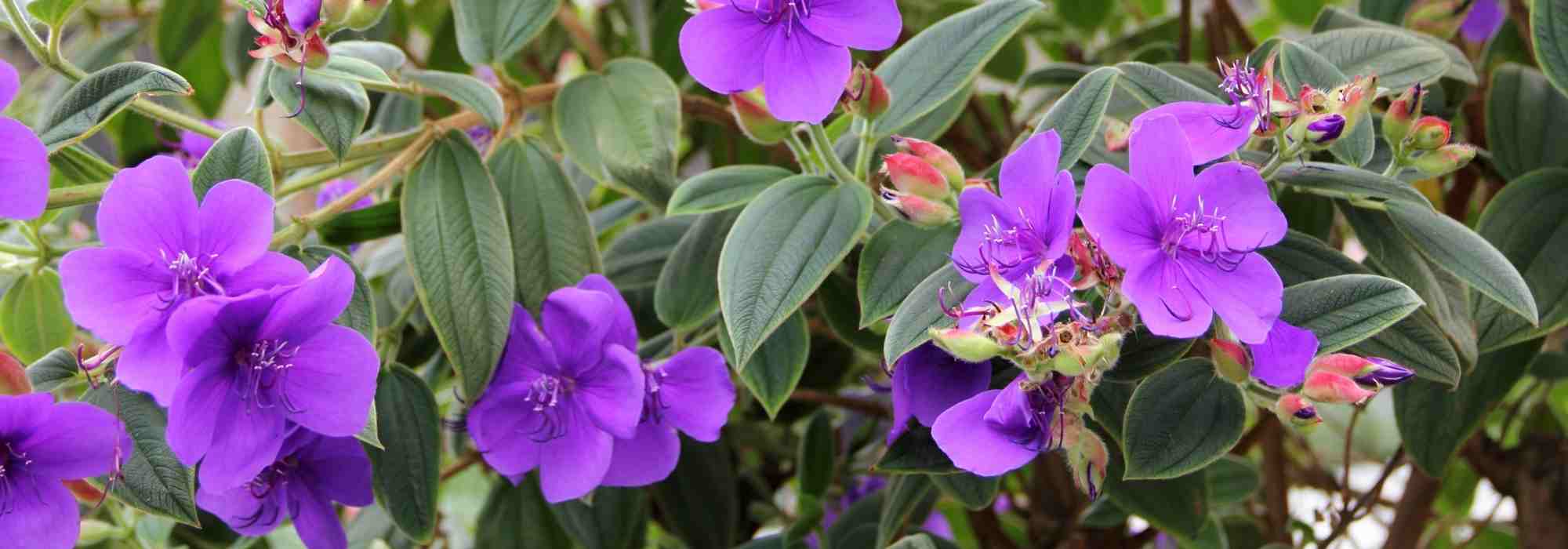
Tibouchina: planting, growing, care
Contents
Tibouchina in a nutshell
- It is a beautiful tropical shrub that is not hardy and acclimatises to the outdoors but only in a well-sheltered spot and in a mild climate
- It possesses an indecent beauty, with velvety foliage and a late but exceptional bright blue-violet flowering that irresistibly attracts all eyes
- In open ground, it should be reserved for oceanic or Mediterranean climates, but elsewhere, it adapts very well to pot cultivation indoors or on the terrace, to be stored away in winter
- Its growing is reserved for knowledgeable enthusiasts or attentive gardeners: it requires regular watering in summer and careful installation
- It is ideal for adding an exotic touch to gardens in our most temperate regions
A word from our expert
Tibouchina is a stunning South American shrub with velvety foliage, where numerous large purple flowers bloom, featuring hooked stamens that resemble tiny spider legs, hence its nickname “spider flower”.
In mid-summer and sometimes until the first frosts depending on the regions, it offers a spectacular flowering of a bluish-purple that is almost fluorescent. Among the 350 species in the genus, Tibouchina urvilleana or Urville’s Tibouchine is the most commonly cultivated.
For this cold-sensitive plant, outdoor cultivation is reserved for regions with very mild winters. However, it adapts well to pot cultivation, which should be brought indoors during winter elsewhere. It will spend the entire beautiful season outside and winter in a greenhouse, conservatory, or even inside the house in a room that is not too heated.
It loves warmth but hates wind, fears frost, and cannot tolerate scorching sun or insufficiently cool soils!
With its exotic appearance, it is a rather demanding bush but will reward you if it is placed in a warm spot sheltered from winds and frost, and if you dedicate a little time to it!
Discover this bush with its outrageous beauty and Brazilian diva temperament!
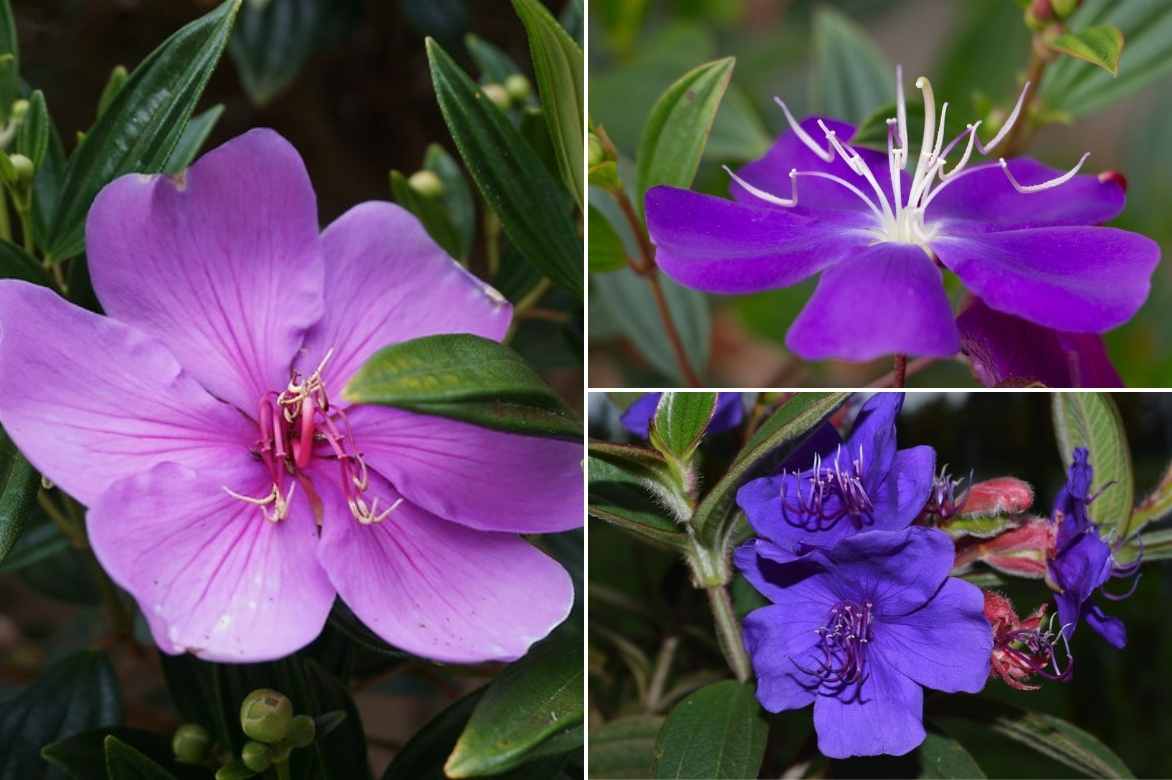
The flowers of Tibouchinas range from mauve to intense blue
Botany
“`html
Botanical data
- Latin name Tibouchina
- Family Melastomataceae
- Common name princess flower, glory bush
- Flowering August to the first frosts
- Height 0.80 to 5 m
- Exposure Sun, Partial shade
- Soil type rich and light, cool
- Hardiness frost-sensitive
The Tibouchina, also known as Tibouchine or “Spider flower”, is a shrub of tropical origin from the family Melastomataceae. It is native to South America, particularly Brazil. It grows naturally in Brazilian and Mexican forests and has naturalised in many tropical and subtropical regions. As such, it enjoys warm atmospheres, and its cultivation in open ground is reserved in our climates for certain coastal areas spared from frost. Not hardy, it is often grown as an indoor plant in our latitudes or in pots to be sheltered in winter.
The genus Tibouchina comprises 350 species of shrubs, undershrubs, and climbing perennials, including Tibouchina granulosa, Tibouchina grandifolia, and Tibouchina organensis. Under our skies, Tibouchina urvilleana (synonyms Lasiandra semidecandra, Tibouchina semidecandra, Pleroma macrantha), also known as ‘Urville’s Tibone’, is the most prized.
Growing quite rapidly, this fabulous shrub has a bushy and upright habit, somewhat angular but not very branched. In its native environment, it can reach 5 m in height with a spread of 2.5 m, but in our gardens, it will rarely exceed 2.5 m in all directions when grown outdoors, provided conditions are optimal. Its silhouette is distinctive: it forms a small tree with a short trunk from which a few branches emerge. There are dwarf tibouchinas, less than 1 metre in height, such as the compact “Groovy Baby”.
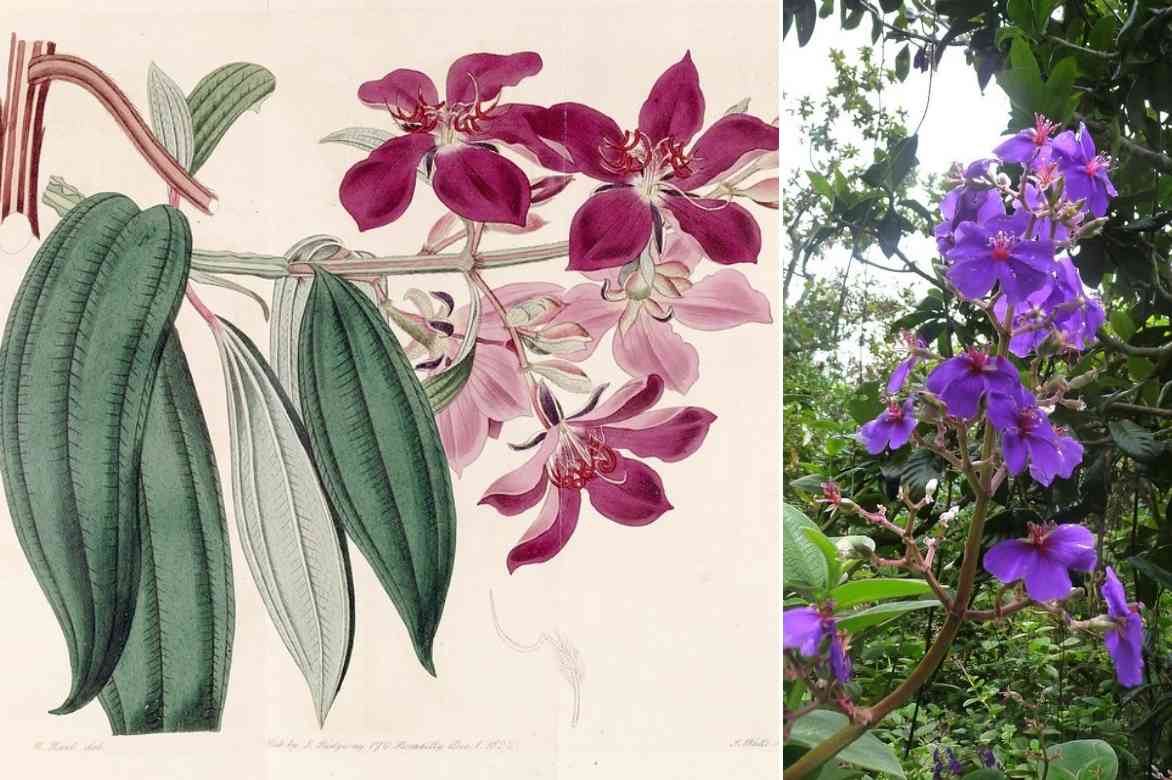 Botanical plate from 1882 and spectacular flowering of Tibouchina
Botanical plate from 1882 and spectacular flowering of Tibouchina
The quadrangular, slender, and brittle branches, reddish and pubescent when young, evolve to greyish-brown hues as they lignify. They bear evergreen to semi-evergreen foliage depending on the climate, which is elegant and particularly ornamental due to its velvety texture. The leaves, 5 to 10 cm long, entire, and oblong in shape, end in a fine point and are marked by 3 to 5 very pronounced longitudinal and symmetrical veins. They are covered with transparent bristles, giving the lamina a fine down with silky reflections. Emerald green in colour with a red edge, duller on the underside, they take on beautiful orange hues in autumn. In full bloom, the velvety foliage echoes the extraordinary violet of a spider-like flowering.
The remarkably long flowering period extends over several months. It begins in August and continues uninterrupted until the first frosts in October-November, then ceases in winter due to reduced sunlight and temperatures. The Tibouchina boasts a fascinating flowering of an almost fluorescent blue-violet of rare intensity in the plant world. The flower buds, solitary or clustered at the tips of the shoots, are tinged with red before opening. They bloom into large, well-opened cup-shaped flowers, 5 to 10 cm in diameter, composed of 5 overlapping satin petals. The centre of these large corollas reveals large, also violet, stamen that are curved and hooked like little spider legs, which has earned the plant the nickname “spider flower”.
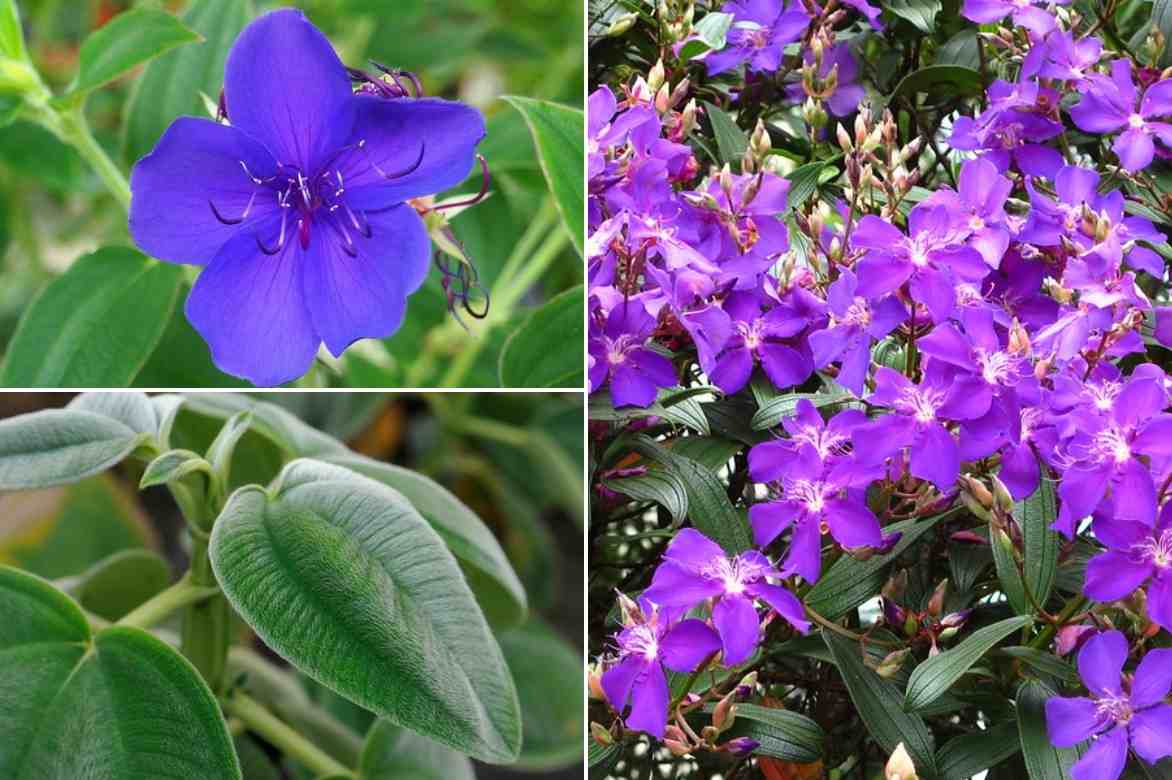 Blue inflorescence (Photo: T. Grau), velvety foliage (Photo: M. Hansen), and plant habit (Photo: M. Halpern)
Blue inflorescence (Photo: T. Grau), velvety foliage (Photo: M. Hansen), and plant habit (Photo: M. Halpern)
“`
Main species and varieties
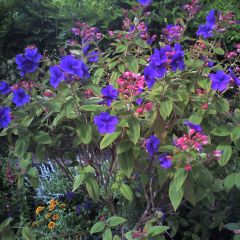
Tibouchina urvilleana
- Période de floraison September to December
- Hauteur 2,50 m
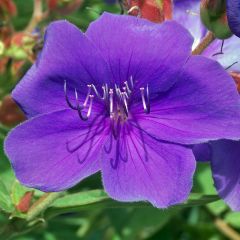
Tibouchina Groovy baby
- Période de floraison September to December
- Hauteur 80 cm
Planting
Where to plant Tibouchina?
Tibouchina is a tender perennial bush that rarely withstands temperatures below -3°C (in very sheltered situations). It should only be planted in the ground in coastal gardens of our most privileged regions, spared from frost. It can be planted without concern from the Atlantic coast to the Mediterranean shoreline, provided that in the orange zone, it receives more frequent watering in summer.
Elsewhere, in colder regions, it will be grown in a pot on the terrace or balcony during the warm season and stored in winter in a conservatory, greenhouse, or in a room of the house that is not too heated. You can bring it outside during the warm season. It will particularly thrive in a greenhouse or conservatory with light but without direct sunlight.
Like all tropical plants, it enjoys warm environments. In our mildest regions, place it in a sheltered position from prevailing winds (the stems and branches break easily) and frost, in a very bright location. Its late flowering encourages planting in well-protected spots from cold and wind. However, in the south of our country, it will fear overly hot sun in summer during the hottest hours of the day and will prefer dappled sunlight.
It should be planted in light, rich but well-draining soil that remains cool, but never waterlogged during the entire flowering period. Its roots cannot tolerate excess water that would cause them to rot. Avoid calcareous soils as well.
It can be planted in the heart of a flowerbed, in isolation, or against a well-exposed and sheltered wall.
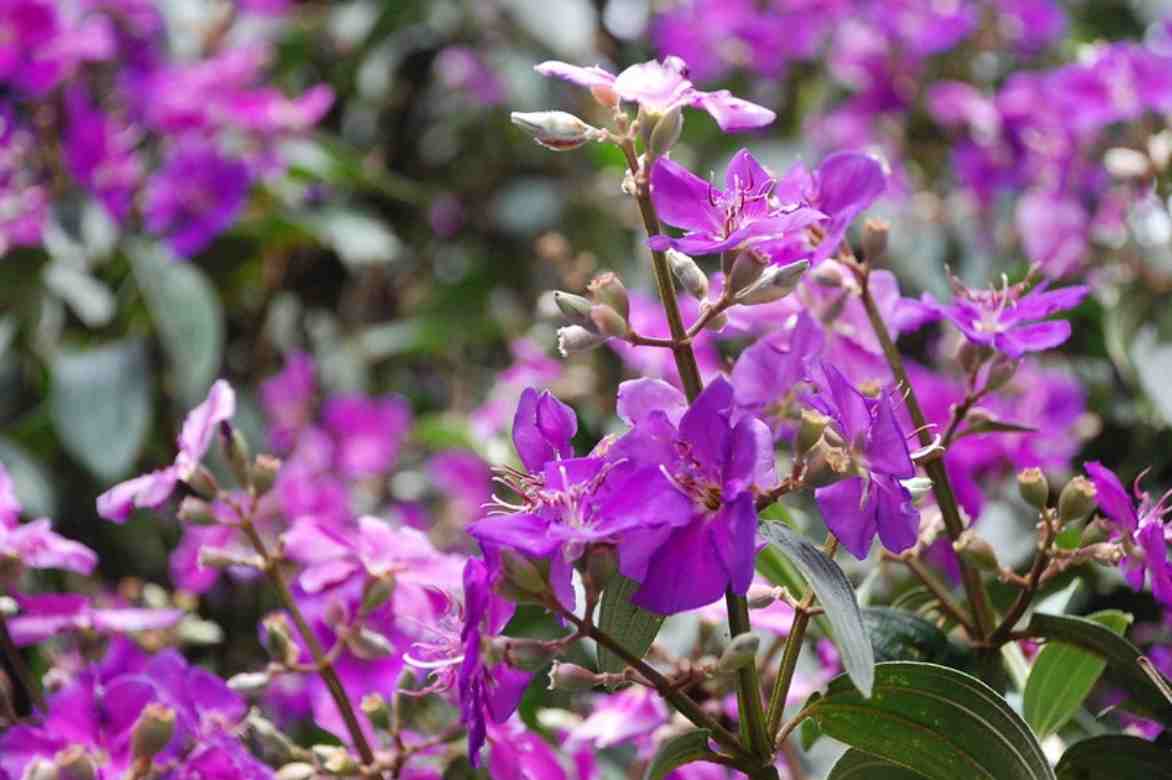 Tibouchina thrives in very sunny garden situations
Tibouchina thrives in very sunny garden situations
When to plant?
In the ground, plant the Tibouchina after the last frosts. It will flower from the first summer.
How to plant it?
It appreciates slightly acidic soil.
In the ground
- Dig a hole two to three times wider than the root ball
- Spread a layer of gravel or clay balls at the bottom of the planting hole to allow for good drainage
- Plant in a mixture formed of good garden soil, compost, and a little heather soil (no more than 30%)
- Firm down
- Water
In a pot
- In a large pot, spread a good layer of drainage (gravel or clay balls)
- Plant in a rich, well-draining mixture composed of potting soil, compost, and 1/3 heather soil
- Firm down lightly and water at planting, then regularly during flowering without excess, allowing to dry between waterings: the substrate should never completely dry out
→ Learn more about the cultivation of Tibouchina in pots in our article!
Read also
10 perfect bushes for a seaside gardenGrowing and care
Tibouchina is a temperamental plant reserved for attentive gardeners willing to dedicate some time to it, as it has its requirements! It demands a well-protected location, a mild climate, careful planting, and regular care.
In summer, for the two years following planting, it requires regular watering (twice a week) during the hot summer days, as soon as the soil is dry.
Add well-decomposed compost in autumn, and a handful of leaf mould in spring, along with crushed horn and dried blood at the base of the bush in early summer.
In pots, more regular watering is necessary, as well as the addition of fertiliser for flowering plants every 15 days. In our less temperate regions, store the pot in a frost-free area but in light, such as a lightly heated conservatory or greenhouse. Reduce watering to once every 15 days and stop fertilising. Never leave water in the saucers.
Bring your pot outside in May as soon as the outdoor temperature is mild, avoiding direct scorching sunlight.
In regions with mild winters, still protect the aerial parts of the bush with a fleece.
Pruning is done after flowering, in October. This helps to balance or reduce the shape, rejuvenate the stems, and promote growth and flowering: remove dead wood, shorten the tips of spent branches, and if your Tibouchina has suffered from winter, you can cut it back severely to 30 cm from the ground.
→ Learn more in our article Tibouchina: how to protect it from the cold and ensure successful wintering
Diseases and potential pests
Tibouchinas grown in a greenhouse or conservatory are susceptible to red spider mites and mealybugs.
Remove mealybugs with a cotton pad soaked in 90°C alcohol, then treat with sprays of rapeseed oil and soap. Repeat two or three times at 15-day intervals.
To combat red spider mites, regularly spray non-limestone water on the foliage to maintain a humid environment around the pot; these pests prefer warm, dry atmospheres.
How to take cuttings of tibouchina?
Propagation is done in a warm, humid environment.
- At the end of summer, take semi-woody cuttings 10 to 15 cm long just below a pair of leaves.
- Remove the leaves at the bottom of the stem and take off the flowers.
- Dip in plant hormone.
- Insert them three-quarters into individual pots filled with a mixture of fine potting soil and sand, kept moist but not waterlogged.
- Place in a warm spot during winter, in light but out of direct sunlight, under a cloche or plastic cover.
- After 3 weeks, remove the plastic.
- Water regularly.
- Transplant them into the ground or pots in spring, when temperatures have risen.
Associations
Tibouchina adds an exotic touch to somewhat rigid flower beds. It makes an ideal subject at the centre of a bed of summer flowering perennial plants alongside the vibrant orange blooms of Echinacea, cannas, or shrubby cinquefoils (Hopley’s Orange). The red flowers of shrubby salvias (‘Royal Bumble’, ‘Flammenn’) will provide a beautiful contrast with its large electric violet flowers. This large tender plant easily combines in a shrub bed with many flowering shrubs of mild climate such as the Cape Fynbos.
In mild climate gardens, it can be grown against a well-exposed wall where it will flower abundantly, alongside tender climbing plants such as Black-eyed Susans.
For an exotic decor, pair it with Eucalyptus macrocarpa, Leucadendron ‘Safari Sunset’, Caesalpinia gillesii, and Melaleuca gibbosa.
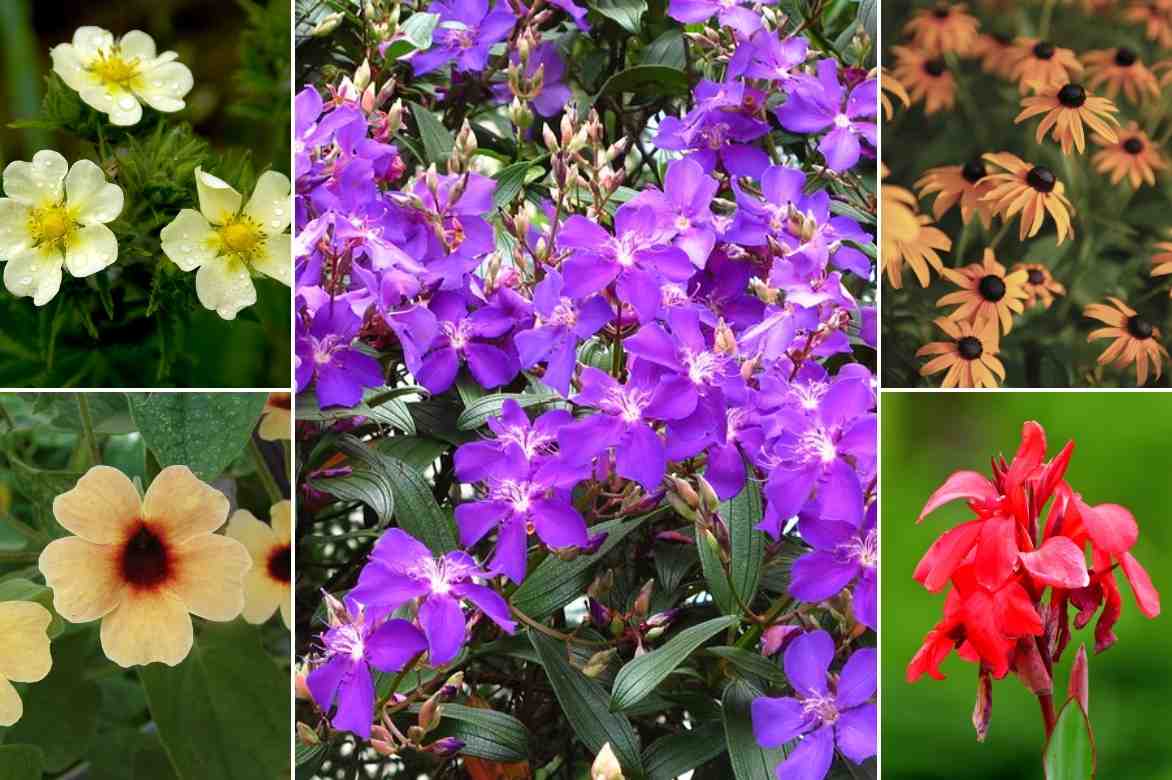
Tibouchina alongside Potentillas, Black-eyed Susans, Echinaceas, and Cannas
Useful resources
-
- Discover our bushes for oceanic and coastal climates
- Find out how to protect your Mediterranean shrubs in winter
- Subscribe!
- Contents































Comments